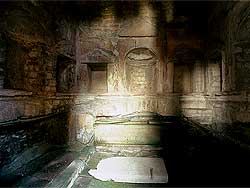The sarcophagus against the backside (the only sarcophagus still
in place) has a frontplate decorated with strigiles (undulating
lines). Inside two skeletons have been found,
a small ring, a golden necklace and a still unreadable coin.
The tomb dates originally from the time of Hadrian.
The inner walls were divided by a simple moulding into a lower part
with arcosolia and an upper part with richly decorated niches
for urns.
Under the black and white mosaic floor too formae have been found.
These were divided by tuff walls and closed with tiles.
In the middle of the second century the tomb has been rebuilt
for inhumation.
 The
three described sarcophagi (180-190 AD) are silent witnesses (two
of them are in the Ostian museum). The
three described sarcophagi (180-190 AD) are silent witnesses (two
of them are in the Ostian museum).
The building of the courtyard dates from that period too.
(click
to continue tomb 11)
|


